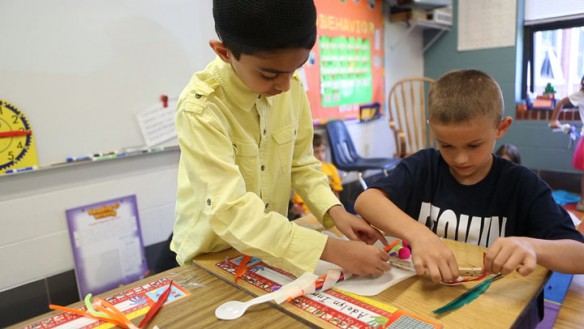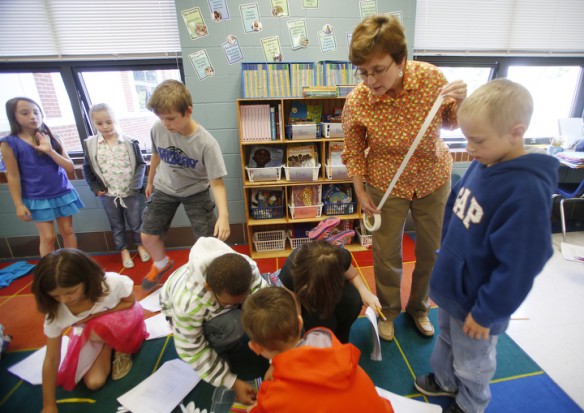
Mustfa Malik and Chase Smith work together building their design of an animal that could transfer a lot of pollen during Debbie Lewis’ 2nd-grade class at Morningside Elementary School (Elizabethtown Independent). Photo by Amy Wallot, May 19, 2014
By Brenna R. Kelly
Brenna.kelly@education.ky.gov
CaMareius Caldwell used pipe cleaners to poke tiny holes through a thin layer of modeling clay. His creation, if it worked, would scatter seeds.
“If we used our fingers it would be too thick,” he said, and the flour, being used to simulate seeds being spread by an animal, would fall through in one big clump.
As CaMareius and his partner built their seed delivery system, other students in the second-grade classroom at Morningside Elementary huddled in pairs using bright feathers, pompoms, pipe cleaners, and clay to build their own models. None of the students noticed – or cared – that it was almost lunchtime.
“I love the level of engagement they have with this,” said teacher Debbie Lewis, as the students piled their creations with flour and unleashed them over a mat to see how much area they could cover.
“Now I want you to go in your notebook and write,” she told her students, “Was your design successful? Would you do anything differently?”
The project was the culmination of a lesson from Launch, a new science, technology, engineering and math curriculum for kindergarten through fifth grade from Project Lead the Way. The program is the expansion of the non-profit organization’s STEM-based curriculum, which is already being used in 155 middle and high schools in the state.
Morningside Elementary (Elizabethtown Independent) and Elkhorn Elementary (Franklin County) were two of 44 elementary schools in the country to pilot the Launch program.
Each lesson is filled with short stories, videos, and activities on iPads that teach vocabulary, math and science concepts. At end of the lesson students are presented with a design problem and must use what they have learned to build something to solve the problem. Students design and build a model, test it, then evaluate how it performed and explain whether it worked.
Introducing younger students to critical thinking and problem solving at an early age will help them succeed in STEM fields and in life, said Melinda Curless, STEM Initiatives consultant for the Kentucky Department of Education.
“It’s empowering for kids to see themselves as problem solvers, and this self-efficacy will likely result in improved learning in all disciplines,” Curless said. “This shift in teaching has the potential to change our student’s trajectories if we begin at a very young age and follow through in their K-12 experience.”
Students in the Launch program are being exposed to a new way of learning science that will soon become the norm in all Kentucky elementary schools. The PLTW Launch is designed to be aligned to the Next Generation Science Standards (NGSS) which teachers will begin implementing this fall. Under the new standards, students will engage in the process of science and engineering and naturally develop critical thinking and problem-solving skills.
“The new standards by construction are really what we mean by STEM education,” Curless said. They integrate science and engineering with math, reading and technology.
For example, students have will have to construct a reasoned argument, supported by data, explaining why one design solution meets the criteria and constraints of a problem better than another design solution. That worries some elementary school teachers, said Susan Ryan, Elizabethtown’s PLTW delegate.
“You talk to a first- or second-grade teacher and they read something like that (standard) and they are like, ‘Oh my gosh, what does that mean and are first-graders capable of doing something like that?’” she said.
Traditional elementary science instruction has been heavy on memorization and more focused on life sciences, she said.

Debbie Lewis passes out tape for students to use on their models they designed to replicate an animal transferring pollen 2nd-grade class at Morningside Elementary School (Elizabethtown Independent).
Photo by Amy Wallot, May 19, 2014
“Now with the Launch process it’s all about, this is your design problem, these are your science concepts that you need to understand to adequately solve the design problem. Now let’s see what you can do,” she said. “And by the way, there’s not one right answer. And we don’t want anybody to have the same answer in the class.”
While design thinking and engineering might sound l complicated, it’s more relatable to real life than teachers may think, Curless said.
“It is a change for elementary teachers, and in general they are kind of scared because it sounds hard, but they just don’t realize that they make design decisions every day,” she said. “When you plan dinner you’re designing around the constraints of what you have in your refrigerator and your pantry.”
The benefit of the Launch program is that it’s a ready-made curriculum aligned to the new standards, teachers said, but it won’t replace all science instruction.
So far, 19 elementary or intermediate schools from seven Kentucky districts have signed up to teach the curriculum this fall, said Mark Harrell, director of school engagement for PTLW’s Midwest region.
This year the pilot schools used 12 engineering-based modules, which will be available to all schools this fall. Another pilot program for the next school year will include computer science and biomedical lessons. Morningside Elementary hopes to participate in that pilot and will continue with current Launch curriculum, Ryan said.
The cost of implementing the program can vary greatly depending on the number of classes and students using it, whether school has iPads, and the number of teachers attending the training, Harrell said. The startup cost could be $10,000 for a school without iPads, which would include all materials for kindergarten through fifth grade, but the second year costs would be much less, he said.
Schools can pay for the program with money from Title I, SEEK, teacher training, Box Tops or grants, he said.
“This is an investment in the community that creates critical thinkers and a future workforce,” Harrell said.
In Elizabethtown, the district’s education foundation paid a portion of the cost and the district paid the rest, Ryan said.
“We invested in this program as well because our kids need to be better prepared when they come to middle and high school,” she said. “You cannot wait until middle and high school to have a solid science foundation for the kids. It just doesn’t work.”
Teacher Mindy Helm saw that science foundation take hold in some of her first graders at Morningside.
“You have some students that come out with these brilliant ideas that may never have voiced them in math or reading,” she said, “but science has opened a brand new door for them.”
For a lesson on light, Helm’s students were tasked with making a structure that would protect children on the playground from UV rays. The lesson used plastic beads that change colors when exposed to UV rays. Students made bracelets then tried to make them change color with indoor lighting – nothing happened. Then they went outside. The white beads turned to purple, orange, blue or pink.
Helm asked her students about why the beads wouldn’t change inside, explained the UV index and how UV light causes sunburn and cataracts.
“It opens the door for a lot of really great conversations,” she said. “The kids give me their ideas, it kind of gives me a good perspective of where they are coming from, then I can help guide them toward the main idea or the concept that we learning that day.”
Later the students made shelters using pipe cleaners and tin foil. They put beads underneath to represent children. They then had to explain their design to the class.
“It was just really cool,” Helm said, “and they were just very happy and really excited to share what their design was and their thinking behind it.”
In addition to teaching students problem solving skills early, starting STEM education in elementary classrooms could help break down the traditional barriers to STEM fields, said Curless, KDE’s science consultant.
“Minorities and females tend to not go into STEM type things because they feel like they can’t, or other girls don’t do it, or other ethnic minorities don’t,” she said. “And so if everybody is doing it from such a young age then potentially it tears down those barriers.”
At Elkhorn Elementary, 11 of the 14 fifth-grade students who stay after school with teacher Rebecca Logan for the program are girls. “I’ve watched so many girls excel in this,” Logan said, as the students drove robots they had built in the program down the hallway.
“We messed up a lot,” said fifth grader Erica Acosta. “We had to go back and redo it again, so we learned from our mistakes.”
The fourth and fifth-grade modules use VEX robotics, which are a simplified version of what is used in the middle school and high school PTLW curriculums. Logan’s students first built the robots, and then learned how to control them with remote joysticks. The next step is to program the robots to move on their own.
After attending the Launch professional learning, Logan trained the others teachers at the school in the curriculum. Initially, some of the teachers were uncertain about the modules, projects and whether students would grasp the engineering concepts. But that uncertainty did not last long.
“They call came out talking about how engaged the children were and how relatable it is to real life,” Logan said. “It’s problem solving. That’s what STEM does, it really helps students problem solve and come up with solutions on their own without somebody giving them the answer. That’s what I love about it.”









Leave A Comment